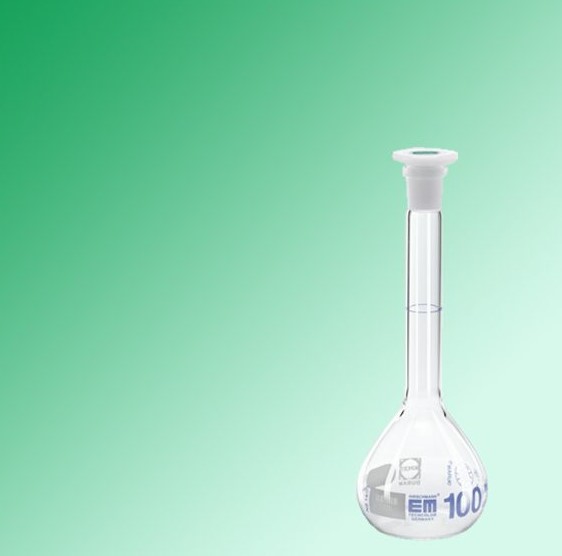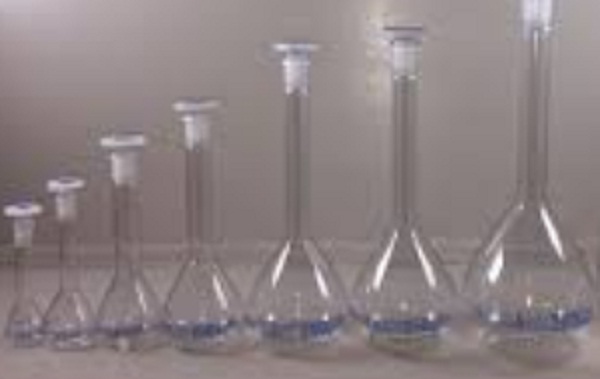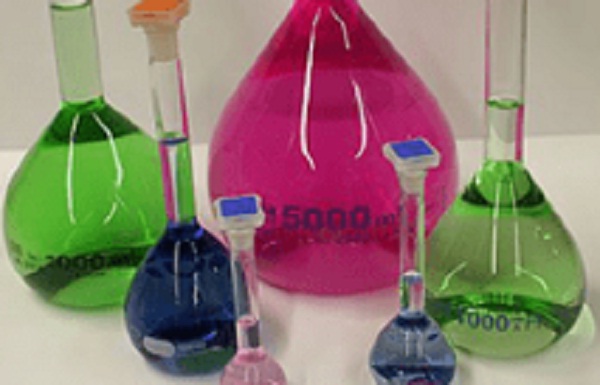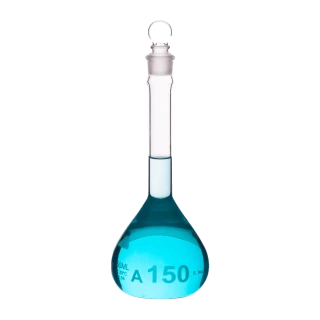- 🌡 What is the use of the flask?
- Who invented the volumetric flask?
- ⭐ How to recognize a flask
- 📌 How to use a flask
- 🧬 What is the use of the ball flask?
- 👉 What is the chemistry course?
- 🌡 When was the volumetric flask invented?
- ⭐ Volumetric flask capacity
- Volumetric flasks features
- Volumetric flasks Calibration
- Types of volumetric flasks
- Importance of correctly filling a volumetric flask
- 📌 Volumetric flask precautions
- Volumetric flasks Applications
- 🧬 Erlenmeyer flask use
- 📍Volumetric flask price
A volumetric flask is a kind of laboratory glassware. It is used to maintain and measure accurate amounts of liquid. It has the shape of a Florence flask, but has a flatter bottom. A volumetric flask has a high, narrow neck with a stopper that can be used to close the opening at the top.
There is a line on the neck to show how much the flask should be filled. Volumetric flasks are made in many sizes - from a few milliliters to liters. They are often used to make liquid solutions. The neck is narrow to make more accurate measurements when making a solution.
🌡 What is the use of the flask?
A flask is a piece of laboratory glass used to prepare and measure chemical solutions. It is used to make a solution to a known volume. Volumetric flasks measure volumes much more accurately than beakers and Erlenmeyer flasks.
A volumetric flask is a type of laboratory flask used to prepare solutions with a precise volume. It is characterized by its cylindrical shape and a volume mark on the neck. The solution is carefully prepared to the mark, which indicates the desired volume, and then it can be used for further experimentation. Volumetric flasks are commonly used in analytical chemistry, biochemistry, and other laboratory settings for precise solution preparation.
Who invented the volumetric flask?
The volumetric flask is considered a very useful tool in laboratories. In scientific studies because it provides important information to the one who uses it. It is found in the history of Moderna chemistry that in the year 1825. The scientist Erlenmeyer Emil, was the one who created the instrument.
Who enters into experimentation and realizes that they need a container with certain characteristics. In order to mix various types of substances, without it turning over, spilling.
⭐ How to recognize a flask
A volumetric flask is characterized by a bulb and a long neck. Most volumetric flasks have flattened bottoms so that they can be placed on a laboratory bench or other surface, although some volumetric flasks have rounded bottoms and must be handled with special protective equipment.
📌 How to use a flask
To prepare a solution in a volumetric flask, follow these steps:
- Measure and add the solute for the solution.
- Add enough solvent to dilute the solute.
- Continue adding solvent until it approaches the marked line on the volumetric flask.
- Use a pipette or dropper to fill the volumetric flask, using the meniscus of the solution and the line on the flask to determine its endpoint.
- Seal the volumetric flask and invert it to mix the solution well.
🧬 What is the use of the ball flask?
It is a kind of flask that is used as a laboratory glassware item. It is used as a container for holding liquids. A Glass flask has a round body, a long neck and often a flat bottom. It is designed for uniform heating, boiling, distillation and ease of turning.
It is manufactured in different thicknesses of glass to withstand different types of use. They are often made of borosilicate glass for heat and chemical resistance. Traditional Florence flasks generally do not have a frosted glass gasket on their longer necks, but typically have a light lip or rim around the tip of the neck. The common volume for a Glass flask is 1 liter.
👉 What is the chemistry course?
A capacity is a circular footprint stamped precisely on the glass of the volumetric instrument to indicate that this is the determined volume. However, we have the case of double capacity, which has an additional line in this opportunity the defined measure is the one established in the middle of both margins
The number of tanks, the accuracy in the precision of the measurements of a tank is a very considerable factor to know the volume of the solution if we keep in mind the consequences that keep incorrect measurements in an erroneous fitting table, which tends to remain in use for a long period of time before the error is indicated.
🌡 When was the volumetric flask invented?
Pyrex has its origins in the early 1910s, when the American glass company Corning Glass Works began looking for new products to present its borosilicate glass, Nonex. At the suggestion of Bessie Littleton, the wife of a Corning scientist, the company began researching Nonex for baking.
After removing the lead from Nonex to make the glass safe for cooking, they called the new formula "Pyrex" – "Py" for the cake plate, the first Pyrex product. In 1916 Pyrex found another market in the laboratory. It quickly became a favorite brand in the scientific community for its resistance to chemicals, thermal shock and mechanical stress.
This object is part of a collection donated by Barbara Keppel, wife of C. Robert Keppel. Robert Keppel taught at the University of Nebraska-Omaha after receiving his B.S. in chemistry from the University of California, Berkeley, and his Ph.D. in organic chemistry from M.I.T. The glassware in the Keppel collection spans the nineteenth and early twentieth centuries.


⭐ Volumetric flask capacity
The volumetric flask, available in sizes ranging from 1 mL to 2 L, is designed to hold a specific volume of liquid, usually with a tolerance of a few hundredths of a milliliter, about 0.1% of the capacity of the flask. The flask has a calibration line engraved on the narrow part of its neck. It is filled with liquid, so the lower part of the meniscus is on this engraved line. The calibration line is specific to a given flask; a set of flasks built to hold the same volume will have lines in different positions.
Volumetric flasks features


This laboratory tool is constituted by an upper part. Comprised by a narrow mouth through which liquid or solid substances are introduced, extracted for dilution. A frosted, rubber, cork, plastic plug can be inserted into such a mouth.
It serves to close the container, shake it, ensuring the preservation of the solution, avoid spills of the mixture. It has an elongated, thin neck with a capacity mark (graduated horizontal line), which is how far it should be filled, to obtain accurate measurements.
In the central part, it is rounded in shape, pear-shaped contains the solution. At its base, it is flat which allows it to stand on its own. It has scale with defined capacity. Its elongated neck is for the purpose of stirring the solution. They are calibrated for measuring volumes of mixtures.
They can be made of glass or plastic, have a scale indicating the volume of the substance. They are easy to identify due to their shape. In their constitution they have information about the capacity, the unit of measurement, the type of glass, the manufacturer's brand.
- Material: Made of glass or plastic (polypropylene or polymethylpentene)
- Shape: Cylindrical with a flat bottom
- Volume Mark: Clearly marked on the neck to indicate the desired volume of solution
- Accuracy: Calibrated to a high degree of accuracy to ensure accurate solution preparation
- Capacity: Available in a range of volumes, typically from 1 milliliter to 1000 milliliters.
- Mouth: Usually has a narrow neck with a ground glass stopper or screw cap for closure.
- Label: May have a label indicating the manufacturer, material, and volume capacity.
Volumetric flasks Calibration


Calibration of a volumetric flask is the process of determining the accuracy of the volume mark on the flask. This is usually done using reference standards, such as water or other solutions of known density, to verify the accuracy of the volume mark. The calibrated volumetric flask is then used to prepare solutions of known volume for further experiments or analysis. Calibration of volumetric flasks is important to ensure accurate results in laboratory experiments and analysis. The frequency of calibration can vary based on the use and handling of the flask, but it is generally recommended to calibrate at least annually.
Types of volumetric flasks
- Volume capacity: Available in a range of volumes, from 1 milliliter to 1000 milliliters or more.
- Material: Glass or plastic (polypropylene or polymethylpentene)
- Shape: Standard cylindrical or specialized shapes for specific applications
- Type of closure: Ground glass stopper, screw cap, or other types
- Graduation style: Single scale or dual scale (indicating both metric and imperial units)
- Accuracy: Class A or Class B, with Class A being the highest level of accuracy
- Application: General purpose or specialized, such as for volatile or toxic solutions.
Importance of correctly filling a volumetric flask
When performing a measurement with laboratory instruments, two types of errors can be incurred, errors due to excess and errors due to default unfailingly. Errors in measurements can be minimized by increasing the appreciation of the measuring instruments.
In the laboratory, as a rule, excess measurements are carried out to ensure that there is a sufficient amount of sample for the experiment. The correct technique to trace a liquid, with the exception of liquid mercury, is to match the meniscus valley of the liquid with the capacity line (excess measurement). and never the ridges of the meniscus of the liquid with the capacity line. (default measurement.
📌 Volumetric flask precautions
- The pipette should never "hold" on the bulb.
- The pipette should "never" be used to extract strong acid or base.
- We must never blow the last drop attached to the pipette nozzle.
- The conical flask must not be rinsed with the solution to be filled.
- The base must be taken in the conical flask and the acid in the burette (for titrations).
- The volumetric flask should "never" be used to measure solutions.
Volumetric flasks Applications
- Analytical Chemistry: Preparation of standard solutions for titrations and other analytical procedures.
- Biochemistry: Preparation of buffer solutions and other reagents used in biochemical experiments.
- Pharmaceuticals: Used to prepare and dispense medication and other solutions in a controlled manner.
- Environmental Testing: Used to prepare samples for analysis in fields such as air, water, and soil testing.
- Education: Used as a teaching tool in chemistry and biology classrooms to demonstrate solution preparation and measurement.
- Quality control: Used in industrial settings to ensure the accuracy of the volume of liquids used in production processes.
Volumetric flasks are valued for their precise volume markings, ease of use, and versatility, making them an essential tool in many laboratory settings.
🧬 Erlenmeyer flask use
Also called as conical flask (titration flask), it is a kind of laboratory flask that is characterized by having a flat bottom, a conical trunk and a cylindrical neck.
Erlenmeyer flasks have wide bases, with edges that contract upwards to a short perpendicular neck. They can be graduated, and often frosted glass or enamel stains are used where they can be labeled with a pencil. It differs from the beaker in its conical body and narrow neck.
The mouth of the Erlenmeyer flask may have a molded lip that can be stopped or covered. Alternatively, the neck can be equipped with ground glass or another connector for use with more specialized plugs or for attachment to other appliances.
* The conical edges and the reduced neck of the flask allow the contents of the flask to be combined by shaking it, without danger of spills.
• While the titration is being performed, it is placed under the burette.
* Their reduced necks also manage to withstand filter cones.
• They are used in microbiology for the preparation of microbial cultures.
• It can also be used to measure the volume of liquids. But this is not recommended for very accurate volume measurements.
• The mouth of the flask can be closed with a cork to prevent gaseous substances from escaping. These can be stored in the flask.
The reduced necks of the flasks can also hold the filter funnels. The last two characteristics of the flasks basically make them suitable for re-crystallization. The specimen to be purified is heated to a boil and enough solvent is added to complete the dissolution. The receiving flask is filled with a tiny portion of solvent and heated to a boil. Its stamped volumes are approximate with an accuracy of about 5%.
📍Volumetric flask price
There are different ways to get the prices of these instruments on social networks, for example in mercado libre Venezuela there are sales of different prices where you can choose here I leave some: Volumetric flask 25 ml, Brand Pyrex Bs. 8.752.240. Lara. Of 25 ml Pyrex Bs brand. 1.200.000 Used - Monagas.
For 10ml, 25ml, 100ml And 500ml Bs. 1.200.000 Used - Sucre. With Lid 25 ml Bs. 8,000,000 Capital District. While 25 ml 50 ml and 100 ml Bs. 2,000,000 Carabobo. For 10 ml, 25 ml And 1000 ml Bs. 9.000.000 Used - Bolivar. With Long Neck 100ml 250ml 500ml Bs. 5.600.000 Capital District.
Of 100 ml, 500 ml, 250 ml And 50 ml Bs. 2.400.000 Capital District. Volumetric flask Of 25ml Bs. 3,000,000 Aragua. Of 2000 ml Long Neck Pyrex Bs. 1.200.000 Zulia. 1000 ml volumetric balloon Bs. 500.000 Used - Carabobo. From 2000 ml of glass. Bs. 1,200,000 Bolivar.
Amber with lid 250,1000ml Bs. 1,200,000 Carabobo. Flat Short Neck 500 ml Bs. 1.200.000 Used - Lara. Flat Bottom Of 250 ml Bs. 1.200.000 Capital District. Also in mercado libre Colombia, Volumetric flask With Clear Glass Stopper 25 ml - 5337.

